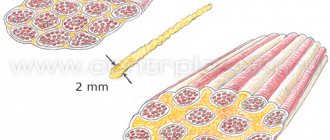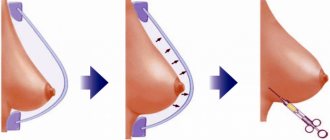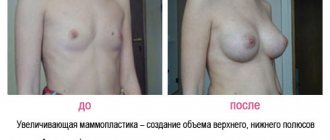Today, you can change the size and adjust the appearance of your breasts in many ways. When using implants, there is always a risk of developing complications that are associated with the body's reaction to foreign bodies. Lipofilling, which involves the use of a woman’s own adipose tissue, does not have this drawback. In addition to a high degree of safety, lipofilling is characterized by low trauma, which is also a significant advantage.
Lipofilling began to be used in plastic surgery relatively recently and almost immediately gained high popularity. In addition to the advantages described above, using your own fat allows you to avoid incisions and post-operative scars, as well as perform a comprehensive body correction in one operation - remove excess fat tissue from one area and add volume in other areas.
Lipofilling is used not only for breast enlargement, but also for the purpose of correcting the face, buttocks, etc. Adipose tissue can be selected from different areas. As a rule, these are the abdomen, thighs and buttocks. At the same time, your own fat is not a foreign body, and therefore does not cause rejection or inflammation.
Like any other technique, lipofilling is not without its drawbacks. Not all transplanted tissue is guaranteed to survive, and some fat will be absorbed over time. Therefore, most often this intervention is carried out in 2-3 stages.
Breast augmentation using your own fat (fat grafting, lipofilling) gives excellent results. The method of breast enlargement using your own fat is safe and quite reliable.
Before performing the fat grafting procedure for breast augmentation, it is necessary to carry out certain preparations, namely
- it is necessary to perform preliminary stretching of the breast tissue with a special Brava apparatus,
- remove fat using liposuction,
- process the fat.
Fat grafting can be performed as an independent operation, and can also be used to eliminate various complications associated with implants (e.g., ripping)
- removal of implants with simultaneous breast lipofilling,
- combined breast augmentation surgery using fat and implants (composite augmentation).
History of fetgrafting (lipofilling) of the breast
Fat grafting has a long history of use in breast surgery. Fetgrafting techniques, which are used on the face, were developed to transfer fat to the breast area. Plastic surgery has accumulated vast experience in fat grafting for both reconstructive and aesthetic purposes. The method is used to improve various breast defects.
In 1987, concerns were raised about the safety of the procedure, and a moratorium on breast augmentation with autologous fat was introduced, which remained in effect for almost 20 years. Later, independent studies were conducted that proved that fat transfer is safe, reliable and, most importantly, does not interfere with the diagnosis of breast cancer. As a result, the ban on the procedure was lifted.
As breast augmentation with fat gained popularity, more attention began to be given to the development of concepts for pre-harvesting, processing and direct transplantation of autologous fat.
The initial enthusiasm for fat grafting led to the belief that fat grafting would soon replace breast augmentation with implants. But this did not happen.
Fat grafting plays an excellent role in breast enlargement and also helps in correcting the problems that arise during enlargement with implants. The practice of fat grafting for breast augmentation instead of breast implants is the exception rather than the rule. Patients who undergo only fat grafting for augmentation make up less than 10% of the total number of patients.
A woman who wants to enlarge her breasts using her own fat is usually categorically against implants. Such patients, as a rule, wish to enlarge their breasts by 1 size. The patient also receives enormous benefits from liposuction, which is performed to remove adipose tissue.
Preparation for breast lipofilling surgery
All patients must undergo preoperative mammography. They must not have cancer or any genetic predisposition to it. Patients should be assessed for any significant comorbidity that may increase their risk for safe liposuction.
Cigarette smoking is a contraindication due to impaired microcirculation and increased fat necrosis and oil cysts.
Pre-stretching of breast tissue with Brava expander
Without sufficient stretching of the breast tissue, fat grafting will lead to an increase in internal pressure, which in turn will lead to increased death of fat cells and, consequently, a decrease in breast volume. The stretching of the gland tissue should be sufficient. For this purpose, special Brava expanders are used.
The BRAVA expander was originally developed in the 1990s as an external soft tissue expander for breast augmentation. Patients need to wear semi-rigid cuples around the chest, like a bra. The device is usually worn for 4-6 weeks. This creates a vacuum-like effect on the breasts, which causes the blood supply to the mammary glands to increase and the tissue to stretch.
Mechanism of action of BRAVA
Negative pressure creates an effect on cells, leading to active cell division, angiogenesis and increased growth factors. It is hypothesized that these same actions occur in breast tissue during BRAVA expansion. The use of pre-expansion in breast augmentation allows for predictable results.
The use of pre-expansion before surgery not only stretches the skin envelope, but also increases the soft tissue matrix, thereby making the recipient site more vascularized, allowing for larger volumes of fat to be injected, and ultimately promoting successful outcomes.
Pre-expansion improves the results of fat grafting due to the following four important points:
- The total parenchymal space for fat grafting (graft-to-capacity ratio) is increased.
- The intercellular pressure in the mammary gland decreases for a given volume of the introduced graft.
- Irregularities in the contour of the gland are identified before fat transfer.
- Vascularization and angiogenesis improve, which leads to increased fat viability.
What should be the ratio of the transplanted fat to the stretched skin sheath?
The concept of graft-to-dermal sheath capacity ratio is critical to successful fat grafting. The graft-to-capacity ratio corresponds to the ideal amount of filler for fat grafting at a specific recipient site. By increasing the volume of the skin by pre-expansion, it is possible to increase the volume of injected fat.
The increased parenchymal space created by the expansion allows for more fat to be injected. But fat must be injected in such a way that it does not itself cause an increase in tension in the breast tissue. Fat grafts should simply be placed as a filler or “space holder.” Finally, pre-expansion promotes angiogenesis.
The patient should be closely monitored throughout the expansion period. Achieving final expansion is critical to successful fat grafting.
Once the skin expansion is complete, the patient prepares for surgery.
There are several important points when preparing fat for transplantation, these are the selection
- the best place to collect fat,
- optimal cannula size,
- the correct negative pressure and force of cannula movement that fat cells may encounter.
The patient is marked with areas for fat collection. There is usually enough fat for grafting, even in a thin person. Thin patients require moderate fat harvesting from several areas, including the anterior abdominal wall, back, flanks, and thighs.
In the past, fat processing required high-speed centrifugation. The purpose of centrifugation was to concentrate the fat as much as possible and remove excess liquid. Centrifugation resulted in significant cell death. Moreover, this process is relatively labor-intensive and inefficient.
Moderate centrifugation is now performed, resulting in better fat viability and larger injectable volumes. The preparation method includes washing the fat to separate blood, lidocaine, etc.
Implants: for those who want more
From the point of view of a radical increase, when the patient wants to “jump” from size 2 to 4, it makes more sense to choose implants. Then you will get a more predictable and predictable result. The implants are modeled specifically for you, to suit your physiology, and as a result, you get the breasts you want for many, many years.
To be fair, it should be said that in this case you can try lipofilling. But this will not be one, but at least 3-4 consecutive operations with delicate enlargement.
In the case where “size matters,” of course, lipofilling is significantly inferior to implantation, because with the help of implants you can achieve almost any desired result (at least size 5) at once, with a guarantee of no loss of volume or any other unforeseen situations in the future. With lipofilling, even the most venerable and experienced surgeon will not be able to accurately predict the degree of shrinkage of new fat, and therefore the future size of the breast. Something will resolve, something will take root...
Methods for collecting and processing fat
Fat is collected using a multi-channel cannula connected to a standard linear aspirator. Typically a cannula with multiple holes is used.
The fat is then transferred into 60 ml syringes, which are loaded into a sterile centrifuge with a low speed bucket handle. The centrifuge rotates for 2-3 minutes, resulting in approximately 20-40 fat.
About 15-20% of the additional crystalloid fluid is removed. The result is a less concentrated fat that is not very thick and is ready for injection.
Low force centrifugation results in low concentrated fat that can be easily injected into the pre-expanded breast.
The goal of fat injection should be to accurately distribute fat throughout all layers of the breast.
Possible complications
Like any other operation, breast lipofilling is accompanied by temporary adverse reactions, including:
- swelling of soft tissues;
- hematomas;
- decreased sensitivity;
- slight soreness.
It is impossible to avoid these complications, but they do not cause serious harm to health and go away on their own within 7–10 days after surgery. More serious conditions rarely develop due to the low traumatic nature of the method.
Composite breast augmentation
Ideal candidates for breast augmentation with implants are patients with adequate breast soft tissue.
Composite breast augmentation using implants and fat is used in cases of revision mammoplasties where there is inadequate soft tissue thickness leading to complications such as ripping. The idea of identifying such patients during primary breast augmentation led to the concept of primary composite breast augmentation.
The ideal candidate for primary comprehensive breast augmentation surgery is a patient who has soft tissue thickness of 1 cm or less and wants large breast implants.
In such cases, the patient is shown the results of combined breast augmentation during the initial consultation and makes a choice between breast implants alone or breast implants with autologous fat transfer.
How to perform breast augmentation using your own fat
The operation consists of two main stages. First, the surgeon removes the required amount of fat using liposuction.
After this, the resulting adipose tissue is prepared. It must be cleared of blood and destroyed cells. Next, the purified fat is injected into the breast area through small punctures.
The operation lasts several hours. It can be performed under either local or general anesthesia.
The result after lipofilling is noticeable immediately. However, it takes several months for it to fully take hold. During this period of time, the swelling subsides, part of the transplanted fat is absorbed, and the breast takes on its final appearance. The recovery period is easy. During rehabilitation, it is necessary to limit physical activity, avoid going to the sauna, swimming pool, solarium, and follow other recommendations of the surgeon.
Complications after surgery may include swelling, hematomas, loss of skin sensitivity, and asymmetry of the mammary glands. Some women experience complete resorption of the transplanted tissue and, as a result, no effect from lipofilling.
Rehabilitation
At first, it is important to follow these recommendations:
- sleep only on your back for a week after surgery;
- exclude physical activity for the first three weeks;
- avoid overheating;
- use ointments and creams prescribed by your doctor for speedy regeneration.
In total, the rehabilitation period is a month. The final effect will be visible approximately three months after the operation.
Achievements in aesthetic medicine help a woman create harmony between her inner and outer beauty. Our clinic skillfully brings this idea to life, helping you become even more beautiful.









